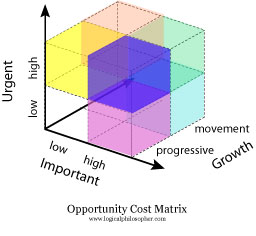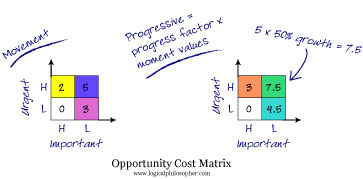It has been over a year, but I finally have posted part II. See here for Part I.
If you recall I postulated, in the context of our knowledge economy in the information age, why we are too busy working to get any work done. Why? With RSS aggregators email and other technologies to pass us information the instant is it written, there is becoming too much information to filter out. We can spend all day working, filtering information and passing it to others, but in the end we have not moved forward to our end goals. No closer to finishing that business proposal, strategic planning article or personnel reviews.
So I asked: What is the balance between knowledge & forward progress?To answer this we consider the Urgent vs. Important 2x2 matrix. I suggest a third dimension of Growth is what we need to introduce in order to understand the balance of forward progress and "just getting things done". I refer to this as the "Opportunity Cost Matrix" (see figure below)
In order to determine how we can get more done, and what to focus our priorities on, we need to understand that with this 3D matrix, as we move from working on High Urgency, High Important tasks that will offer our company (or project) high growth rates, there exists a problem when we move to working on other tasks. What is the second more important task? Something that is high urgency and low importance but offers high growth? Or something that is high urgency and high importance, but won't offer much long term growth to the project.
That problem is what I want to consider here.
 Research Question:
Research Question:How does our firms Growth Rate impact our priortization of tasks?
What is the opportunity cost of doing movment based activities over progressive activities?
When should we focus on “Low Urgency” progressive tasks over “High Urgency” movement tasks?
Defining:
Movement = nominal firm growth; target existing sales, general business tasks; status quo.
Progressive = agressive firm growth; target increasing sales, business development & implementation.
Progress factor = opportunity cost (or growth rate) of doing ‘movement’ activities over ‘progressive’ activities.
Now we need to break this down into how we should prioritize things - and I will do so as an example. I will use “progressive” tasks give a 50% firm growth rate over donig “movement” oritented tasks (10 points allocated across matrix). This gives:

This shows the priority of getting work done is as follows:
1) Progressive based High Urgency, High Importance tasks
2) Movement based High Urgency, High Importance tasks
3) Progressive based Low Urgency, High Importance tasks etc...
Plotting this we see:

- If (Progressive Growth Factor) Less Than 67%, focus on movement of high urgency items over progress of low urgency items.
- If (Progressive Growth Factor) Greater Than 67%, focus on progress of low urgency items over movement of high urgency items
Next steps:
How does a different task point allocation alter the model?
How do we actually calculate the progress factor?







0 comments: